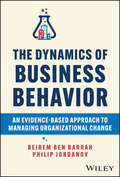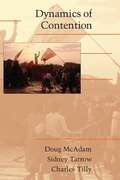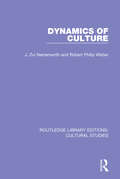- Table View
- List View
A Dynamic Systems Theory Perspective on L2 Writing Development (China Perspectives)
by Shaopeng LiFrom the perspective of empirical complex dynamic systems, this book investigates the complex and nonlinear process of L2 writing centering on three linguistic aspects of L2 writing development: vocabulary, syntax, and discourse.Combining dynamic systems theory, variation analysis, as well as data and cases studies from Chinese EFL learners’ writing, the book critically engages with the heated discussion on dynamic patterns of L2 writing development that focus heavily on the linguistic dimensions of complexity, accuracy, and fluency. The author expands the scope of the research by integrating both linguistic and functional dimensions of L2 output and examines the interaction and co-development of these dimensions. This framework helps delineate a full picture of individual learners’ L2 writing dynamic patterns across all components of their communicative repertoire. The research findings suggest the developmental path of writing system for each EFL learner may differ, which is influenced by their different learning characteristics and learning environments in China.The title will appeal to scholars interested in applied linguistics and second language acquisition. Suggestions on pedagogy and language learning advanced in the book will also make it a useful read for L2 language learner and TESOL and TEFL teachers.
A Dynamic Systems Theory Perspective on L2 Writing Development (China Perspectives)
by Shaopeng LiFrom the perspective of empirical complex dynamic systems, this book investigates the complex and nonlinear process of L2 writing centering on three linguistic aspects of L2 writing development: vocabulary, syntax, and discourse.Combining dynamic systems theory, variation analysis, as well as data and cases studies from Chinese EFL learners’ writing, the book critically engages with the heated discussion on dynamic patterns of L2 writing development that focus heavily on the linguistic dimensions of complexity, accuracy, and fluency. The author expands the scope of the research by integrating both linguistic and functional dimensions of L2 output and examines the interaction and co-development of these dimensions. This framework helps delineate a full picture of individual learners’ L2 writing dynamic patterns across all components of their communicative repertoire. The research findings suggest the developmental path of writing system for each EFL learner may differ, which is influenced by their different learning characteristics and learning environments in China.The title will appeal to scholars interested in applied linguistics and second language acquisition. Suggestions on pedagogy and language learning advanced in the book will also make it a useful read for L2 language learner and TESOL and TEFL teachers.
The Dynamics and Complexities of Interracial Gay Families in South Africa: Gay Relationships In South Africa (Springerbriefs In Sociology)
by Oluwafemi AdeagboThis book provides an in-depth account of a qualitative study on the familial arrangements and domestic settings shaping interracial gay partnerships in the South African context, and it offers both empirical and theoretical insights on the topic. While heterosexual intimate relationships, particularly mixed-race couples, have attracted societal and scholarly attention in South Africa due to the country’s past history of racial segregation, it is, however, striking how little emphasis is placed on understanding same-sex unions in a transforming South Africa. This book is timely and important because it explores the vignettes, complexities and dynamics of interracial gay intimate relationships, an area that hardly gets the scholarly attention it deserves. The book addresses the intersectionality, and the question of how sexuality, gender, racial identity and personal resources influence the relationship as well as the way resilience strategies are drawn upon to sustain the partnership.
The Dynamics and Evolution of Social Systems: New Foundations of a Mathematical Sociology (Theory and Decision Library A: #29)
by Jürgen KlüverWhen I started with this book several years ago I originally intended to write an introduction to mathematical systems theory for social scientists. Yet the more I thought about systems theory on the one side and theoretical sociology on the other the more I became convinced that the classical mathematical tools are not very well suited for the problems of sociology. Then I became acquainted with the researches on complex systems by the Santa Fe Institute and in particular with cellular automata, Boolean networks and genetic algorithms. These mathematically very simple but extremely efficient tools are, in my opinion, very well appropriate for modeling social dynamics. Therefore I tried to reformulate several classical problems of theoretical sociology in terms of these formal systems and outline new possibilities for a mathematical sociology which is able to join immediately on the great traditions of theoretical sociology. The result is this book; whether I succeeded with it is of course up to the readers. As the readers will perceive, the book could not have been written by me alone but only by the joint labors of the computer group at the Interdisciplinary Center of Research in Higher Education at the University of Essen. The members of the group, Christina Stoica, Jom Schmidt and Ralph Kier, are named in several subchapters as co-authors. Yet even more important than their contributions to this book were the permanent discussions with them and their patience with my new and very speculative ideas. Many thanks.
The Dynamics and Social Outcomes of Education Systems (Education, Economy and Society)
by Jan Germen Janmaat, Marie Duru-Bellat, Andy Green and Philippe M�hautSome scholars argue that education systems across the western world are becoming increasingly similar due to the influence of transnational discourses and organizations. Others believe that education is the panacea for all problems of social cohesion. After all, aren't the well-educated usually more tolerant, civically engaged and trusting than the poorly educated? This book critically examines both claims. It finds that western countries still differ markedly on key aspects of their education systems and that these differences reflect distinct political traditions and different responses to a set of competing normative and political principles. The findings further suggest that raising the average education level is unlikely to be an effective strategy for promoting social cohesion. Instead, more promising are policies targeting the opposite ends of the lifelong learning continuum: universalizing pre-school education and care and promoting adult education with a pronounced second chance character.
The Dynamics of Advertising
by Jackie Botterill Iain MacRury Barry RichardsThe authors suggest that advertisments, while important in our daily emotional self-management, are far more closely linked to the pragmatics of everyday life than their symbolic richness might suggest. Recent trends in advertisment content point to an important shift in our relationship to goods that reflects an increasing preoccupation with risk management.
The Dynamics of Advertising
by Jackie Botterill Iain MacRury Barry RichardsThe authors suggest that advertisments, while important in our daily emotional self-management, are far more closely linked to the pragmatics of everyday life than their symbolic richness might suggest. Recent trends in advertisment content point to an important shift in our relationship to goods that reflects an increasing preoccupation with risk management.
The Dynamics of Business Behavior: An Evidence-Based Approach to Managing Organizational Change
by Beirem Ben Barrah Philip JordanovDiscover practical and relevant insights from behavioral science you can apply immediately to manage change in your organization In The Dynamics of Business Behavior: An Evidence-Based Approach to Managing Organizational Change, cognitive neuropsychologist Philip Jordanov and entrepreneur Beirem Ben Barrah deliver an eye-opening new treatment of how to create organizational change with an evidence-based approach. The book includes interviews with more than 40 industry professionals across 15 sectors from companies like Johnson & Johnson and the three biggest Dutch banks discussing change approaches, challenges, and interventions to help bridge the gap between theory and practice. Readers will find useful step-by-step guides on eighteen interventions for six change areas, including psychological safety for stakeholder engagement and re-anchoring for leadership support. This book also discusses: The importance of strategic planning and risk management in DEI efforts through surveys and focus groups, yearly health scans, and qualitative and quantitative data The most common myths that leaders accidentally buy into as they guide their organizations Case studies of contemporary companies overcoming challenges using brain and behavior science A startlingly insightful and, at times, counterintuitive guide to implementing behavioral science in real-world organizations, The Dynamics of Business Behavior: An Evidence-Based Approach to Managing Organizational Change will earn a place on the bookshelves of managers, executives, directors, entrepreneurs, founders, marketers, department heads, salespeople, and other business leaders.
The Dynamics of Business Behavior: An Evidence-Based Approach to Managing Organizational Change
by Beirem Ben Barrah Philip JordanovDiscover practical and relevant insights from behavioral science you can apply immediately to manage change in your organization In The Dynamics of Business Behavior: An Evidence-Based Approach to Managing Organizational Change, cognitive neuropsychologist Philip Jordanov and entrepreneur Beirem Ben Barrah deliver an eye-opening new treatment of how to create organizational change with an evidence-based approach. The book includes interviews with more than 40 industry professionals across 15 sectors from companies like Johnson & Johnson and the three biggest Dutch banks discussing change approaches, challenges, and interventions to help bridge the gap between theory and practice. Readers will find useful step-by-step guides on eighteen interventions for six change areas, including psychological safety for stakeholder engagement and re-anchoring for leadership support. This book also discusses: The importance of strategic planning and risk management in DEI efforts through surveys and focus groups, yearly health scans, and qualitative and quantitative data The most common myths that leaders accidentally buy into as they guide their organizations Case studies of contemporary companies overcoming challenges using brain and behavior science A startlingly insightful and, at times, counterintuitive guide to implementing behavioral science in real-world organizations, The Dynamics of Business Behavior: An Evidence-Based Approach to Managing Organizational Change will earn a place on the bookshelves of managers, executives, directors, entrepreneurs, founders, marketers, department heads, salespeople, and other business leaders.
Dynamics of Community Formation: Developing Identity and Notions of Home
by Ho Hon Leung Yaser Robles Robert W. Compton Jr.This interdisciplinary work discusses the construction, maintenance, evolution, and destruction of home and community spaces, which are central to the development of social cohesion. By examining how people throughout the world form different communities to establish a sense of home, the volume surveys the formation of identity within the context of rapid development, global and domestic neoliberal and political governmental policies, and various societal pressures. The themes of cooperation, conflict, inclusion, exclusion, and balance require negotiation between different actors (e.g., the state, professional developers, social activists, and residents) as homes and communities develop.
Dynamics of Conflict
by Ronald A. FranciscoThe mechanisms of protest and revolution have been the subject of theoretical research for over a century, yet the lack of data has hindered the empirical validation of conflicting theories. In this book, the author presents a unique new set of sub-daily data from over thirty countries and seven civil wars and uses them to test two models of conflict, the predator-prey model and the competing species model. The dynamic nature of the data modelling and the novelty of the dataset make this work a unique contribution to the field of conflict research. Dynamics of Conflict will help to re-evaluate existing theories and chart a new course towards the formal and statistical modelling of conflict.
The Dynamics of Conflict Between Bureaucrats and Legislators
by Gail JohnsonFirst Published in 1993. Routledge is an imprint of Taylor & Francis, an Informa company.
The Dynamics of Conflict Between Bureaucrats and Legislators
by Gail JohnsonFirst Published in 1993. Routledge is an imprint of Taylor & Francis, an Informa company.
The Dynamics of Conflict Resolution: A Practitioner's Guide
by Bernard S. MayerThis empowering guide goes beyond observable techniques to offer a close look at the creative internal processes--both cognitive and psychological--that successful mediators and other conflict resolvers draw upon.
Dynamics Of Contention (Cambridge Studies In Contentious Politics Ser.)
by Douglas McAdam Sidney Tarrow Charles Tilly Doug McAdamOver the past two decades the study of social movements, revolution, democratization and other non-routine politics has flourished. And yet research on the topic remains highly fragmented, reflecting the influence of at least three traditional divisions. The first of these reflects the view that various forms of contention are distinct and should be studied independent of others. Separate literatures have developed around the study of social movements, revolutions and industrial conflict. A second approach to the study of political contention denies the possibility of general theory in deference to a grounding in the temporal and spatial particulars of any given episode of contention. The study of contentious politics are left to 'area specialists' and/or historians with a thorough knowledge of the time and place in question. Finally, overlaid on these two divisions are stylized theoretical traditions - structuralist, culturalist, and rationalist - that have developed largely in isolation from one another.
Dynamics of Culture (Routledge Library Editions: Cultural Studies)
by J. Zvi Namenwirth Robert Philip WeberThis book, first published in 1987, is a landmark contribution to macrosociology that extends the tradition of Sorokin, Durkheim, Marx, Weber and other founders of the discipline in new and exciting directions. Using their innovative content analysis methodology to examine American and British political documents, the authors show that the long-term dynamics of culture are subject to their own laws and are independent of the actions of 'great men' and other individual actors. This comprehensive volume brings together over two decades of the authors' research on culture indicators. Key findings include the identification of two long-term cultural cycles in the United States and Great Britain: one is related to party realignments, the other to long-term economic fluctuations. In addition, the authors demonstrate how culture provides the themes that political parties use to interpret economic conditions in their appeal for votes. Other results show that organizational cultures move in opposite directions from those in the culture of the larger society. The book also includes detailed discussions of both the methodology used to analyse text content and related metatheoretical issues in the study of cultural dynamics.
Dynamics of Culture (Routledge Library Editions: Cultural Studies)
by J. Zvi Namenwirth Robert Philip WeberThis book, first published in 1987, is a landmark contribution to macrosociology that extends the tradition of Sorokin, Durkheim, Marx, Weber and other founders of the discipline in new and exciting directions. Using their innovative content analysis methodology to examine American and British political documents, the authors show that the long-term dynamics of culture are subject to their own laws and are independent of the actions of 'great men' and other individual actors. This comprehensive volume brings together over two decades of the authors' research on culture indicators. Key findings include the identification of two long-term cultural cycles in the United States and Great Britain: one is related to party realignments, the other to long-term economic fluctuations. In addition, the authors demonstrate how culture provides the themes that political parties use to interpret economic conditions in their appeal for votes. Other results show that organizational cultures move in opposite directions from those in the culture of the larger society. The book also includes detailed discussions of both the methodology used to analyse text content and related metatheoretical issues in the study of cultural dynamics.
The Dynamics of Dementia Communication
by Alison WrayWINNER of the 2021 British Association for Applied Linguistics Book prize It is well recognized that when people are living with a dementia, effective communication can be a challenge for both them and those they interact with. Despite a plethora of good advice, it can be surprisingly hard to sustain constructive communicative behaviours and to integrate them successfully into routine daily care and interaction. The Dynamics of Dementia Communication asks why that is. What is it about communication, as a human social and cognitive practice, that makes it so difficult to manage the disruptions caused by dementia? Why is it so common to feel awkward, confused or irritated when talking with a person living with a dementia? Why is the experience of living with a dementia so personally and socially devastating? What approaches to communication would work best, and why? To answer these questions, the book integrates information from a wide range of different sources, covering the biological, social, and emotional factors associated with the dementia experience. New concepts and theoretical perspectives offer novel ways of thinking about the challenges of communication generally, and in the context of dementia. Topics explored include whether it is acceptable to deceive people living with a dementia and why society's failure to support people living with a dementia and their carers is so devastating. The final chapter suggests what people living with a dementia need if communication is to promote and protect everyone's well-being. By providing a deeper understanding of what topples the best-intentioned attempts at interaction, and by explaining why poor communication affects everyone involved, this book sets new agendas for improving the welfare of people living with a dementia, their families, and professional carers.
The Dynamics of Dementia Communication
by Alison WrayWINNER of the 2021 British Association for Applied Linguistics Book prize It is well recognized that when people are living with a dementia, effective communication can be a challenge for both them and those they interact with. Despite a plethora of good advice, it can be surprisingly hard to sustain constructive communicative behaviours and to integrate them successfully into routine daily care and interaction. The Dynamics of Dementia Communication asks why that is. What is it about communication, as a human social and cognitive practice, that makes it so difficult to manage the disruptions caused by dementia? Why is it so common to feel awkward, confused or irritated when talking with a person living with a dementia? Why is the experience of living with a dementia so personally and socially devastating? What approaches to communication would work best, and why? To answer these questions, the book integrates information from a wide range of different sources, covering the biological, social, and emotional factors associated with the dementia experience. New concepts and theoretical perspectives offer novel ways of thinking about the challenges of communication generally, and in the context of dementia. Topics explored include whether it is acceptable to deceive people living with a dementia and why society's failure to support people living with a dementia and their carers is so devastating. The final chapter suggests what people living with a dementia need if communication is to promote and protect everyone's well-being. By providing a deeper understanding of what topples the best-intentioned attempts at interaction, and by explaining why poor communication affects everyone involved, this book sets new agendas for improving the welfare of people living with a dementia, their families, and professional carers.
The Dynamics of Employee Relations (Management, Work and Organisations)
by Paul Blyton Peter TurnbullThe second edition of The Dynamics of Employee Relations provides a thorough and up-to-date analysis of the changes and underlying continuities occurring in employee relations. It offers a lively and engaging discussion of current debates, drawing extensively on a wide range of case studies. The authors illustrate the critical importance of employee relations in contemporary work organisations and argue that to understand those relations it is important to recognise the tensions inherent in the employment relationship. The result is a well-informed critical and highly readable account.
The Dynamics of Employee Relations (PDF)
by Paul Blyton Peter TurnbullThe Dynamics of Employee Relations provides a critical assessment of employee relations within contemporary organisations. Written in a lively and readable style, The Dynamics of Employee Relations captures the essence of working reality within a variety of working environments. The third edition has been updated to include insights into the latest developments in the field and contains new case studies to illustate the nature of employee relations at the turn of the century. A must read for all undergraduate, postgraduate and MBA students studying employee relations and a valuable resource for anyone engaged in grappling with the challenges presented by employee relations in contemporary workplaces. 9786610860319 9781280860317
Dynamics of Energy Governance in Europe and Russia (International Political Economy Series)
by Caroline Kuzemko, Andrei V. Belyi, Andreas Goldthau and Michael F. KeatingEnergy in Europe and Russia is in flux. This book presents a rich set of case studies for analyzing the complex and intertwined regional dynamics of multiple actors, levels, and policy fields in energy throughout Europe and Russia, with the aim of offering an alternative view to the prevalent geopolitical or neoliberal approaches.
The Dynamics of Federalism in Nigeria
by Ambrose Ihekwoaba EgwimThis book analyzes the concept “true federalism” to examine whether there are definable dimensions of power-sharing that make ‘true federalism.’ The author takes a critical look at dimensions on political restructuring in Nigeria, which have been termed “true federalism.” The work fills a significant gap in the existing literature on the theory and practice of federalism. The project will be useful to the students and professors of African Studies, political science, Nigeria federalism, public administration and policy. Additionally, the monograph will be interesting to the general public who seek to know more about contemporary issues in Nigeria.
The Dynamics of Jewish Latino Relationships: Hope and Caution
by Bridget KevaneThe Dynamics of Jewish Latino Relationships centers around three themes: immigration, race and identity, and faith and religion. Each chapter explores an encounter that, for various reasons, has brought Latinos and Jews together on the same stage.
The Dynamics Of Managing Diversity: A Critical Approach
by Gill Kirton Anne-Marie GreeneFor anyone looking to develop a career in HR or business management, understanding the contexts, policies and practices for developing a sustainable and high performing, diverse workforce is a must. The Dynamics of Managing Diversity was one of the first books to respond to growing academic coverage of the topic of diversity management at degree level. This third edition has been fully updated to reflect new working practice, statistical information and equality and diversity law, as well as including new case studies and information on International policies outside the UK and Europe. Diversity management is a term that covers not only race, disability and sex discrimination, but also broader issues such as individual and cultural differences. The Dynamics of Managing Diversity, third edition, can help to prepare HR and business managers of the future with the legal information and research findings to enable them to develop meaningful diversity policies in their organizations. With: Accessible text including key learning points, activities and discussion questions Practical case studies to illustrate the real-life issues in a local, international and organizational context A new companion and lecturer website, featuring tutor support materials and links to useful sites and additional information Kirton and Greene present the subject of diversity management in a logical and structured manner, beginning each chapter with aims and objectives, and ending with discussion questions. This is the perfect support resource for those teaching or studying in the field of equality and diversity. Gill Kirton, Reader in Employment Relations at the School of Business and Management, Queen Mary, University of London and licentiate member of the CIPD. Anne-marie Greene, Reader in Industrial Relations in the Industrial Relations and Organisational Behaviour Group, Warwick Business School, graduate member of the CIPD. Related Titles Moran et al., Managing Cultural Differences, ISBN: 9780750682473 Holbeche, HR Leadership, ISBN: 9780750681735


















